
International Engagement
A central pillar of the world order the US established in the period after World War II was the principle of collective security which says that nations will contribute to collective military operations and/or using economic sanctions in response to international aggression. This principle was also the basis for the US establishing military alliances and mutual defense treaties with other countries or groups of countries. This principle has become more controversial recently as some have questioned whether the US should sustain such commitments.
As NATO celebrated its 70th anniversary, there was a debate about the role of NATO in international security. The fact that NATO members have historically not met the agreed-upon requirement of spending 2% of GDP for defense has prompted calls by former President Trump and some Members of Congress for the US to threaten to pull out of NATO if members do not increase their defense spending. However, since Russia’s invasion of Ukraine in 2022, most NATO members have been meeting the 2% spending requirement.
Also subject to debate are US treaties with Asian countries. Since 1953 the US has had a mutual defense treaty with South Korea and has 24,000 US troops based in South Korea in support of its commitment. Since 1960, the US has had a treaty with Japan that says that the two countries pledge to join forces and act together if there is an armed attack against Japan or against the 39,000 US forces based there.
|
UPHOLDING THE PRINCIPLE OF COLLECTIVE SECURITY |
|
Survey: PPC, August 2024
Respondents were asked whether it should, “be a high priority in U.S. foreign policy to uphold the principle of collective security, by contributing to collective military operations and/or using economic sanctions in response to international aggression?”
A large bipartisan majority of 80% said it should, including 79% of Republicans and 85% of Democrats. More Details Briefing All nations face the risk of being attacked or invaded by another nation. The key trigger for World War II was that Germany and Japan invaded neighboring countries. After the war, the major countries in the world agreed in the United Nations Charter that the use of military force against another country is a violation of international law, unless it is in self-defense, collective defense, or is approved by the UN Security Council. But, because there is no international police force to enforce the law, they also agreed that when a country comes under attack, other countries should join together to defend the country being attacked, not only through military force, but also through economic sanctions. This is the principle of “collective security.” The idea is that leaders who might have the desire to conquer neighboring countries, will be deterred or dissuaded if they believe that other countries will join together to come to the defense of the country. Some countries have collective defense agreements in which they promise to come to each other’s aid if attacked. We’ll look at those types of alliance arrangements shortly. The UN Charter provides for a looser form of collective security that doesn’t necessarily require participation from members. The UN Security Council agrees on taking action and invites member states to contribute to some type of international response. Collective security was one of the central principles behind the Gulf War in 1991. When Iraq under Saddam Hussein invaded Kuwait, numerous countries joined together, under U.S. leadership, and drove Iraq out of Kuwait. Arguments The arguments in favor did substantially better than those against, overall and among both parties. The pro arguments were found convincing by large bipartisan majorities of around eight-in-ten. The con arguments did do nearly as well, but were still found convincing by small and bipartisan majorities of around six-in-ten. Final Recommendation Demographics Results from Past PPC Survey Related Standard Polls
Very large bipartisan majorities have stated for several decades that defending our allies should be an important US foreign policy goal:
Finally, they were asked whether it should, “be a high priority in U.S. foreign policy to uphold the principle of collective security, by contributing to collective military operations and/or using economic sanctions in response to international aggression?” A large bipartisan majority of over eight in ten said it should, including 77% of Republicans and 89% of Democrats.
Very large bipartisan majorities have stated for several decades that defending our allies should be an important US foreign policy goal:
|
|
MUTUAL DEFENSE TREATIES |
|
Survey: PPC, August 2024 Asked whether “the U.S. should or should not continue to be part of the NATO military alliance,” a large bipartisan majority of 78% said it should, including 70% of Republicans, 87% of Democrats and 75% of independents. More Details Briefing Closely related to the idea of collective security is the idea of mutual defense treaties or alliances. When nations enter into an alliance, they promise that if any one of them is attacked, all of the other members of the alliance will band together and defend that nation. While collective security is a general principle, a mutual defense treaty is a firm commitment to help defend another country or group of countries in the event that they come under attack. An attack on one is considered an attack on all. We will now evaluate some of America’s alliances. Some people believe that these alliances continue to serve U.S. interests and values, while others think that they have grown obsolete. America’s most significant alliance is the North Atlantic Treaty Organization or NATO. This includes 30 European nations, and Canada as well as the U.S. It was formed after World War II with 15 members in response to the concern that Europe might be attacked by the Soviet Union. Later, additional countries were added that were in Eastern Europe and had originally been part of an alliance with the Soviet Union, including Poland, Hungary, the Czech Republic and others. Sweden and Finland joined in the last year in response to Russia’s actions in Ukraine. They were then informed about Article 5 of the NATO charter, which requires members to come to the defense of other members if they are attacked: The NATO charter includes a key section, called Article 5, which says that NATO members regard an attack on any member as an attack on all and that all members will defend any member that is attacked. While a key focus is the potential for an attack by Russia, NATO has addressed other issues as well. After the September 11th attacks on the US, NATO invoked Article 5 and several member countries joined the US in its operation in Afghanistan. Lastly, they were informed about the total military force of the European members of NATO: The military forces of the NATO countries are closely linked, have joint command structures, and do military exercises together to ensure that they will be able to work together effectively if it is necessary to defend any of the members. The U.S. keeps about 100,000 troops stationed in Europe to help defend Europe if necessary and to send a signal of its commitment to help defend Europe. The European members have around 1.7 million troops stationed in Europe. Arguments Final Recommendation Demographics Results from Past PPC Survey Related Standard Polls
A bipartisan majority has supported the general principle that the US should use military force to defend allies:
When asked about the possibility of “scaling back U.S. involvement in NATO” only minorities support it. However no definition of scaling back is provided and large numbers do not give an answer. Support is higher among Republicans.
When the military commitments of NATO membership have been specified, a bipartisan majority has favored the US making such a commitment, but the majority is smaller, and a large share has not provided an answer. But few oppose the commitment.
With no background information, and offered a non-committal option, support for maintaining US membership in NATO has dropped to a plurality, with a large share taking a non-committal position:
|
|
There is a debate over whether the US should reaffirm its commitment to defend its NATO allies, as stipulated in Article 5 of the NATO treaty, in light of statements made by President Trump that have been interpreted as calling this commitment into question in response to NATO allies’ relatively lower defense spending levels. Respondents were presented the following briefing material as part of an in-person deliberative poll by Stanford University’s Center for Deliberative Democracy in September 2019: During and after the Cold War, the US led its partners through alliances and free trade agreements that focused on strategic areas of the globe. The North Atlantic Treaty Organization (NATO), an alliance of the US, Canada, and over twenty European countries, requires members to defend any member attacked by an outside power. Originally, it was part of the US strategy for protecting Western Europe from invasion by the Soviet Union. After the Cold War, NATO expanded to several former Soviet satellites bordering Russia thus antagonizing that country. At the same time, many Western European members significantly reduced their defense spending. In 2014, NATO members all committed to spend 2% of their gross domestic product on defense by 2024, a goal first set in 2002. They were then presented a proposal, and arguments for and against it: Proposal: The US should reaffirm its commitment to defend any NATO ally attacked by a hostile force. Argument in Favor: President Trump has repeatedly called this commitment in question, demoralizing our allies and increasing the chances of Russian military intervention. Our European allies have never in fact called upon the US to repel attacks. Only the US has used NATO this way, in response to 9/11. NATO members honored our call for war against Afghanistan. Argument Against: The NATO commitment increases the chances of war with Russia. President Trump should require large increases in European defense spending before reaffirming our commitment. After reading the briefing material, respondents deliberated with each other in-person before making their final recommendation. On a 0-10 scale, with 5 being “in the middle”, a large bipartisan majority of 83% favored the US reaffirming its commitment to NATO (6-10), including 77% of Republicans and 90% of Democrats. |
|
Survey: PPC, February 2019 For many years there has been concern about the fact that the NATO allies spend a significantly lower portion of their budgets on defense than the US does. There is a debate about whether the US should threaten to withdraw from NATO if European members do not increase their defense spending. Respondents were introduced to the dispute between the US and European NATO members over defense spending levels: For some years now there has been a dispute between the U.S. and other members of NATO about their level of defense spending. The U.S. has complained that it spends about 4-5% of the U.S. economy on its military, while European nations generally spend about 2% or less, some as low as 1%. Europeans point out that the amount that the U.S. spends is not only in Europe but also in Asia and in the U.S. homeland, and that Europe already spends twice as much as Russia, which is NATO’s primary focus. Nonetheless, in 2014, the European NATO partners agreed to set a goal to increase their defense spending to at least 2% of their budget. There have been some increases, but only 4 of the 26 European countries have met this goal, though several more are expected to reach this level within the year. One of the largest countries, Germany, is unlikely to reach it at any point in the near future. They were then told that there is some debate about what the U.S. should do about this situation and were asked to evaluate three options with an argument in favor of each one. Three possible approaches were presented. They were presented the first proposal and an argument in favor: Press European countries to spend more on their military and say that if they do not the U.S. will disengage from Europe militarily and possibly withdraw from NATO The argument did only moderately well with an overall majority of 56% finding it convincing. However, there was a sharp partisan divide: 76% of Republicans, but only 39% of Democrats found it convincing. They were presented the second proposal and an argument in favor: Press European countries to spend more on their military, but NOT threaten to disengage from Europe or withdraw from NATO. The argument did far better than the first argument. Overall 80% found it convincing as did 87% of Democrats. Among Republicans, 72% found it convincing— roughly the same as the 76% who found the argument for the first proposal convincing— suggesting substantial ambivalence. Remain part of NATO but reduce U.S. military investments in Europe to bring them more in line with the level that the Europeans make. The argument also did quite well with 74% finding it convincing. Among Republicans (77%) it did the best of all arguments, with 72% of Democrats concurring.
|
|
UKRAINE-RUSSIA WAR |
|
Survey: PPC, August 2024 Asked whether they favor, “the US continuing to provide military assistance to Ukraine, including military equipment, ammunition, training and intelligence,” 67% were in favor, including 57% of Republicans, 79% of Democrats and 59% of independents. More Details: Briefing They were then presented a briefing on US military assistance to Ukraine, as follows: We will now turn to a key question: whether the US should continue to provide military and other assistance to Ukraine. As you may know, the US has been providing the Ukrainian military: military equipment, ammunition, training and intelligence. It is difficult to put a dollar value on this assistance, as much of the military equipment provided is fairly old and used, but it is roughly some tens of billions of dollars. European countries have been providing an equivalent amount of military assistance. Arguments The second argument in favor, that it is important for US security that Russia does not gain a foothold in Europe, was found convincing by a very large bipartisan majority of 80% (Republicans 75%, Democrats 87%). The second con argument countered that Europe is fully capable of handling the problem itself and challenged the idea that failing to respond to the conflict threatens world order, was found convincing by 59%, including 68% of Republicans and independents, but only half of Democrats (51%). Final Recommendation Demographics Results in Six Swing States Among Republicans, majorities were in favor in Arizona, Georgia, Pennsylvania and Wisconsin (56-60%), while in Michigan and Nevada they were evenly divided. However, majorities of Republicans in Michigan (57%) and Nevada (61%) find it at least “tolerable” (rating the proposal 5 or higher on a 0-10 scale measuring its acceptability). Results from Past PPC Survey Results from Standard Polls
When offered a non-committal option (e.g. not sure, neither favor nor oppose), around one-fifth choose that option, lowering the total percent in support.
When US support to help Ukraine fight against Russia is framed only in terms of financial assistance, without specifying how the funding would be used, a small majority or plurality are in support, but less than half of Republicans.
One question asked whether Congress should “authorize additional funding to support Ukraine.” However the question does not make it clear whether “additional funding” this would entail an increase over and above the current levels of funding. Based on responses to other questions it appears that is how it was interpreted by a substantial number of respondents. Just 45% were in favor with 55% opposed, with 28% of Republicans in favor and 71% opposed. Among Democrats, 62% were in favor (CNN, August 2023) |
|
Survey: PPC, August 2024 Respondents were told that: Both the US and European countries have also been giving Ukraine humanitarian aid, including providing food and shelter, and helping them repair access to water and electricity. So far, the US has given about $39 billion in such assistance. The Europeans have contributed an equivalent amount and have also accepted more than a million Ukrainian refugees into their countries. Another proposal is for the US to continue giving humanitarian assistance to Ukraine. Asked whether they favor, “the US to continue giving humanitarian assistance to Ukraine,” a bipartisan majority of 74% were in favor, including 65% of Republicans, 84% of Democrats and 69% of independents. Demographics Results in Six Swing States Results from Past PPC Survey |
|
Survey: PPC 2023 Respondents were asked whether they approve of the US-NATO agreement, by which the US would:
Asked for their final recommendation, 73% approved, including 63% of Republicans, 86% of Democrats and 64% of independents. Majorities in all types of congressional districts were in favor of the fighter jet agreement, from very red to very blue districts, with no significant variation. More Details: Briefing Respondents were briefed on this topic, as follows: Now let’s turn to a specific type of military equipment that Ukraine has been asking the US and other NATO members for – fighter jets. Until recently only a few NATO countries provided a limited number of fighter jets to Ukraine, and Ukraine has asked for more. NATO countries did have more fighter jets they had bought from the US, but the US did not permit them to transfer them to Ukraine (A condition of the sale was that the US can say who they may transfer the jets to.) Recently, at the urging of other NATO members, the US shifted its positions and agreed to allow them to provide those fighter jets to Ukraine. The US also agreed to provide training to Ukrainian pilots on how to operate these fighter jets. Whether the US should have agreed to this has been debated. Arguments The first argument in support stated that this type of advanced military equipment is essential for Ukraine to push back Russian forces, and was found convincing by 75% (Republicans 67%, Democrats 86%). The argument against, that this sends an escalatory signal to Russia who could respond with a nuclear attack, was found convincing by 58%, including 66% of Republicans, but just 47% of Democrats. Final Recommendation They were again presented the US-NATO agreement by which the US would:
Asked for their final recommendation, 73% approved, including 63% of Republicans, 86% of Democrats and 64% of independents. Majorities in all types of congressional districts were in favor of the fighter jet agreement, from very red to very blue districts, with no significant variation. Demographics |
|
ALLIANCES WITH SOUTH KOREA AND JAPAN |
|
Survey: PPC, February 2019 There has been a concern over whether US military presence in South Korea is still beneficial to the US and the rest of the world. Respondents were briefly informed about the mutual defense treaty between the US and South Korea, and US military presence in South Korea: As you may know, the United States has had a mutual defense treaty with South Korea since 1953. The U.S. keeps 24,000 troops in South Korea. These troops are to help defend South Korea if necessary and to send a signal of America’s commitment to help defend them. The U.S. regularly does military exercises with South Korean forces to ensure that they will be able to work together effectively if it is necessary to defend them. These troops are also used for other purposes in Asia. South Korea covers 40 percent of the costs of basing U.S. troops there. Currently, there is some debate about whether the U.S. should continue to have a mutual defense treaty with South Korea. | |
|
Survey: PPC, February 2019 Respondents were first presented a briefing on mutual defense treaties and the US' treaty with South Korea (see above). Then, asked whether the US should, “continue to have a mutual defense treaty with South Korea,” a bipartisan majority of 87% said it should, including 86% of Republicans and 89% of Democrats.
Arguments Arguments for and against keeping this treaty were then evaluated. The argument in favor did substantially better, overall and among both parties, than the argument against, which was not found convincing by any majority. Demographics
|
|
Survey: PPC, February 2019 Respondents were first presented a briefing on mutual defense treaties and the US' treaty with South Korea (see above). Then, asked whether they approve of, “the U.S. having 24,000 troops stationed in South Korea,” a bipartisan majority of 76% approved, including 80% of Republicans and 74% of Democrats.
Arguments Respondents evaluated arguments for and against the US continuing to have 24,000 troops based in South Korea. The argument in favor did overwhelmingly better. The pro argument was found convincing by nine in ten, overall and among both parties. The con argument was found convincing by just four in ten, overall and among both parties.
Demographics
Asked about the number of US troops in South Korea, clear majorities have found the number acceptable.
Majorities would favor partial withdrawal of US troops from South Korea if North Korea agreed to give up its nuclear arsenal, but not complete withdrawal:
|
|
Survey: PPC, February 2019 Respondents were briefly informed about the mutual security treaty, and US military presence in Japan: As you may know, the United States has had a mutual security treaty with Japan since 1960. According to this treaty, the two countries pledge to join forces and act together if there is an armed attack against Japan or against U.S. forces based there. The U.S. keeps 39,000 troops stationed in Japan. These troops are to help defend Japan, if necessary, and to send a signal of America’s commitment to them. The U.S. regularly does military exercises with Japanese forces to ensure that they will be able to work together effectively if it is necessary to defend them. These troops are also used for other purposes in Asia. Japan covers 75 percent of the cost of basing U.S. troops there. Currently, there is some debate about whether the U.S. should continue to have this mutual security treaty with Japan. | |
|
Survey: PPC, February 2019 Respondents were first presented a briefing on mutual defense treaties and the US' treaty with Japan (see above). Then, asked whether the US should, “continue to have a mutual defense treaty with Japan,” a bipartisan majority of 87% said it should, including 88% of Republicans and 88% of Democrats.
Arguments Arguments for and against keeping this treaty were then evaluated. The arguments in favor did substantially better, overall and among both parties (88% for all), than the argument against, which was not found convincing by any majority (44%, Republicans 44%, Democrats 41%). Demographics
Less than half have support the use of US troops to defend Japan if they enter a conflict with China over disputed islands, with opposition decreasing since 2015:
|
|
Survey: PPC, February 2019 Respondents were first presented a briefing on mutual defense treaties and the US' treaty with Japan (see above). Then, asked whether they approve of, “the U.S. having 39,000 troops stationed in Japan,” a bipartisan majority of 76% approved, including 80% of Republicans and 76% of Democrats.
Arguments Respondents evaluated arguments for and against the US continuing to have 39,000 troops based in Japan. The argument in favor did overwhelmingly better. The pro argument was found convincing by around 87%, including 88% of Republicans and 85% of Democrats. The con argument was found convincing by just four in ten, overall and among both parties. Demographics
Asked about the number of 39,000 US troops in Japan, a majority has found the number acceptable.
|
|
AUTHORIZATION FOR USE OF MILITARY FORCE |
|
Survey: PPC, January 2022 A bipartisan majority of 59% favor repealing the 2001 Authorization for Use of Military Force, which has given Presidents broad authority to initiate military operations against any country, organization or person who was involved with or helped those involved with the September 11th attacks. Support for repealing includes 65% of Democrats, 63% of independents, and a bare majority of Republicans (52%). Majorities of voters in very red (55%) to very blue (66%) congressional districts are in favor. More Details Briefing Respondents were introduced to the context of the proposal as follows: As you may recall, shortly after the 9/11 attacks Congress passed a resolution that gave the president (who was then George W. Bush) the authority to use military force against:
What is controversial is that over the last two decades the 2001 AUMF has been repeatedly used as the legal basis for using military force against organizations that were not involved with 9/11, but have similar beliefs and readiness to use terrorist methods. Since it was passed, the 2001 AUMF has been used by Presidents Bush, Obama, Trump and Biden as the legal basis for dozens of military operations against various organizations in various countries around the world. These include extended operations (longer than 60 days) in Syria, Somalia, Yemen, Libya, and Iraq. The proposal was then presented: A proposal has been put forward to repeal the 2001 AUMF. As discussed above, the President would still have the power to use military force to defend against organizations deemed an imminent threat. But to have an operation that would last longer than 60 days the President would need to get a new AUMF from Congress. Arguments Both pro and con arguments were found convincing by bipartisan majorities. The pro argument proclaimed that the 2001 AUMF has been a “blank check” for warfare and has been used beyond its original intent. Three-quarters found this convincing (GOP 69%, Dem 81%, Ind 73%). The con argument declared that it has been necessary to defend the US against terrorist forces, and was found convincing by 55%, including 61% of Republicans and a bare majority of Democrats (52%). Independents were divided. Final Recommendation In the end, respondents were asked whether they favor the following proposal: Repeal the 2001 Authorization for Use of Military Force (AUMF) which has given the president the authority to use military force against:
A bipartisan majority of 59% favored repealing the 2001 AUMF, including 65% of Democrats, 63% of independents, and a bare majority of Republicans (52%), Majorities of voters in very red (55%) to very blue (66%) congressional districts were in favor. Demographics
A large bipartisan majority favored President Obama asking for Congressional approval to continue using force against ISIS, authority which was later justified using the 2001 AUMF:
Status of Legislation |
|
ARMS SALES |
|
Survey: PPC, January 2022 A bipartisan majority of 61% favor the proposal to give Congress more control over arms sales by requiring a simple majority of Congress to approve any arms sale over $14 million, rather than the current system which requires a veto-proof majority (two-thirds) to stop an arms sale proposed by the President. Majorities of Republicans (56%), Democrats (68%) and independents (61%) favor this proposal.
More Details Briefing Respondents were introduced to context of the debate about the roles of Congress and the President regarding arms sales, as follows: Now let’s turn to another issue: the sale of US-made military equipment -- such as planes, missiles, tanks and military computer technologies -- to foreign governments. As you may know, Congress passed a law in 1976 that gave the President the power to approve all such arms sales. This law states that Congress can disapprove of a sale of military equipment over $14 million dollars. But the President can veto such an action. Then it would require a two thirds vote in both houses of Congress to override the veto. In fact, Congress has never succeeded in stopping an arms sale. The proposal was then presented: Currently, there is a proposal that would make it more possible for Congress to stop an arms sale over $14 million. Rather than Congress having the power to vote to stop an arms sale--and possibly be vetoed--arms sales could only occur if a majority in Congress were to vote in favor of the sale. This would mean that Congress could stop a sale with 51% of votes in both houses of Congress, while currently it could require 2/3s of both houses. Arguments Both pro and con arguments were found convincing by a bipartisan majority. The pro argument voiced the concern that, since arms sales have such a big impact on foreign policy, they should not be left up to one person. Seventy-one percent found this convincing (GOP 66%, Dem 78%, Ind 68%). The con stressed that the President should have more power than Congress over foreign policy and any military-related activities. Fifty-seven percent found this convincing, with little partisan difference (GOP 59%, Dem 57%, Ind 54%). Final Recommendation In the end, respondents were asked whether they favor or oppose the following: Any deal to sell US-made military equipment to a foreign government that is worth over $14 million must be approved by a majority of Congress. A bipartisan 61% favored the proposal, including 56% of Republicans, 68% of Democrats and 61% of independents. Majorities in very red (57%) to very blue (61%) congressional districts were in favor. Demographics |
|
WAR POWERS ACT |
|
Survey: PPC, January 2022 A bipartisan majority of 58% favor a proposal to give Congress more control over military operations initiated by a President, by requiring the President to get the approval of a simple majority of Congress to continue the operation for longer than 60 days, rather than the current system which requires a veto-proof majority (two-thirds). A majority of Republicans (53%), Democrats (62%) and independents (58%) favor the proposal, as do those in every type of congressional districts, from very red (59%) to very blue (62%). More Details Briefing Respondents were first introduced to context of the debate over the roles of Congress and the President regarding war powers, as follows: The Constitution gives both Congress and the President a role in the use of military force:
A less clear area is when the President might use military force outside of the framework of a declaration of war. To answer this question, in 1973 Congress passed the War Powers Act. It states that the President may at times use military force without first getting Congressional approval. But if Congress does not vote in favor of continuing the action within 60 days, the President must stop the military action and withdraw the forces. Nonetheless, all Presidents since then have taken the position that, though they may ask Congress for approval, because the President is the Commander in Chief, they do not need Congressional approval to use military force. They were informed that Presidents Reagan, Clinton and Obama had violated the War Powers Acts, and that: In each case, Congress had the option of taking an action to cut off funding for the military operation. However, if Congress were to do that, the President could veto such an action. Then it would require two thirds of the votes in both houses of Congress to override that veto. This is politically difficult to achieve. They were then provided the specific proposal: Currently, there is a proposal that would make it more possible for Congress to stop a President’s military operation. Rather than Congress having to vote to stop a military operation--and possibly be vetoed--the military operation could only continue after 60 days if a majority in Congress were to vote in favor. If Congress does not vote to continue the operation within the 60 days, funding will be automatically cut off. That way the President could not veto this cut-off. (This would not apply to military actions in response to a direct attack on the US or its military.) Arguments All of the pro and con arguments were found convincing by bipartisan majorities; but the pro arguments were found convincing by about ten percentage points more people than the cons. The first pro argument exclaimed that our government only functions on checks and balances, and that right now, they are largely absent when it comes to war powers. Seventy-six percent found this convincing (GOP 72%, Dem 81%, Ind 70%). The first con argument rebutted this idea by stating that the Constitution clearly gives the President, as Commander in Chief, full power over military activities. Sixty-four percent found this convincing (GOP 68%, Dem 62%, Ind 59%). The second pro emphasized that use of the military has too many consequences for our foreign policy to be left in the hands of one person, and was found convincing by 71% (GOP 66%, Dem 77%, Ind 68%). The con countered by proclaiming that having just one person in charge is necessary to take quick, decisive action to protect US security, and was found convincing by 60% (GOP 64%, Dem 57%, Ind 59%).
Final Recommendation In the end, respondents were asked whether they favor the following: Make it more possible for Congress to stop a President’s military operation. Rather than Congress having to vote to stop a military operation - and possibly be vetoed - the military operation could only continue after 60 days if a majority in Congress were to vote in favor. If Congress does not vote to continue the operation within the 60 days, funding will be automatically cut off. That way the President could not veto this cut-off. (This would not apply to military actions in response to a direct attack on the US or its military.) A bipartisan majority of 58% favored the proposal, including 53% of Republicans, 62% of Democrats and 58% of independents. An analysis of voters by congressional district type, broken out using Cook’s PVI ratings, shows that majorities in all types of districts are in favor, from very red (59%) to very blue (62%). Demographics |
|
THE UNITED NATIONS AND ITS AGENCIES |
|
Survey: PPC, June 2025 A bipartisan majority of 84% said the US should work through the UN and its agencies more or about the same as it has been, including 74% of Republicans and 93% of Democrats. A majority nationally (52%) and among Democrats (63%) favor the US working through the UN more.
More Information Briefing Respondents were provided background information on the United Nations: The UN was established after World War II. It is currently made up of 193 Member Nations – nearly all of the nations in the world. According to the UN, it provides a forum for its members:
Member nations also work within the UN to agree on international rules in areas such as international trade, ocean navigation and intellectual property (e.g. patents). They were informed of the three main parts of the UN:
The last part of the briefing on the UN presented information about how the UN is funded, and how much the US tends to contribute: The UN and its agencies are funded primarily by dues from member nations. The total budget of the UN and its agencies is about $68 billion a year. Most nations contribute to the UN and its agencies an amount that is about equal to their share of the world economy. For example, if a nation’s economy is 10% of the world economy, then that nation is expected to fund about 10% of the budget of the UN overall and each UN agency. Many poorer nations contribute less than their share of the world economy. To make up for that, some wealthier nations contribute more than their share. The US currently contributes $14 billion out of the UN’s total $68 billion in spending, which comes out to a bit less than its share of the world economy. However, because the US economy is so large, it still contributes more money in total than any other nation. Arguments Respondents evaluated three pairs of arguments for and against whether the US should participate in various UN agencies. Each of the arguments were found convincing by bipartisan majorities, but the arguments in favor of the US participating in UN agencies did consistently better -- nationally, among Democrats, and in two out three cases among Republicans.
Related Standard Polls When asked a general question about what approach the US should take to address international problems, a large bipartisan majority has preferred the US working with other countries, even if that means compromising, rather than working alone:
Asked whether the US working through the UN is important and a benefit to the US, majorities have said it is, although less than half of Republicans say it provides a benefit (down from half just a couple years prior):
|
|
Survey: PPC, June 2025 A bipartisan majority of 81% favor the US participating in the UN Department of Peace Operations, which helps run the UN's peacekeeping activities. This includes 76% of Republicans and 89% of Democrats.
Briefing Respondents were informed of the mission, main activities and budget of the UN Department of Peace Operations: One of these major UN agencies is the UN Department of Peace Operations, which works to promote and monitor peace agreements between parties in conflict. UN peacekeeping operations can only take place if the main parties of the conflict agree to the presence of the peacekeepers. All operations must also be approved by all of the five permanent members of the UN Security Council, including the US. In other words, the US and other permanent members can veto any operation. Peacekeeping activities include:
These operations are staffed by diplomats, military personnel, law enforcement officers, and civilians. They come from various countries. There are currently 11 peacekeeping operations with about 60,000 personnel. The US generally only contributes a small number of military personnel (currently 26) who are usually higher ranking officials in charge of planning and coordinating missions. The US also provides military intelligence to the operations. The biggest peacekeeping operations are currently in South Sudan and the Central African Republic, where there have been civil wars. The annual budget for UN peacekeeping operations is about $6 billion. Related Standard Polls Asked about a specific situation in which the US could be involved in international peacekeeping activities - the Israel-Palestine conflict - a majority has been in favor:
|
|
Survey: PPC, June 2025 A bipartisan majority of 79% favor the US participating in the World Health Organization, including 70% of Republicans and 91% of Democrats. Respondents were informed of the World Health Organization's mission, main activities, and budget: Another agency is the UN’s World Health Organization, with a mission to improve health globally, by:
The agency has an annual budget of around $3 billion.
Related Standard Polls When asked a general question about the approach the US should take when providing global health aid, a bipartisan majority has preferred the US working together with other countries rather than working alone:
However, when asked whether the US should withdraw from the World Health Organization - shortly after the Trump administration started its withdrawal process - just half were opposed, with a large percent not providing an opinion, and a majority of Republicans were in favor.
Status of US Participation in the WHO In January 2025, the Trump administration started the one-year process of withdrawing the US from the WHO, and has prohibited federal employees from communicating with the WHO or its staff. It is unclear whether the President legally has unilateral authority to do so, but the majority of Members of Congress have not taken any action to either approve or nullify that decision, and so the process of withdrawal is proceeding. |
|
Survey: PPC, June 2025 A bipartisan majority of 81% favor the US participating in the UN World Food Program, including 78% of Republicans and 88% of Democrats. Respondents were informed of the mission, main tasks, and budget of the UN World Food Program: Another agency is the UN World Food Program, with the mission to reduce hunger and save lives. Its main tasks include:
Besides paying its dues, the US contributes food directly, which it purchases from US farmers. The agency has an annual budget that ranges from about $6 to 10 billion.
|
|
Survey: PPC, June 2025 A bipartisan majority of 83% favor the US participating in the UN International Children's Fund, including 79% of Republicans and 88% of Democrats. Respondents were informed about the agency's mission and budget: Another agency is the UN International Children’s Fund. It has a mission to help provide children with healthcare, education, and clean water, and protection from violence and exploitation (such as child labor). The agency has an annual budget of around $9 billion.
|
|
Survey: PPC, June 2025 A bipartisan majority of 77% favor the US participating in the UN Development Program, including 69% of Republicans and 87% of Democrats. Respondents were informed of the agency's mission, main activities, and budget: Another agency is the UN Development Program which has a mission to help countries find ways to reduce poverty and promote long-term economic development. The UN Development Program offers technical help and advice for governments, and funding for non-profit organizations for projects that focus on:
The agency has an annual budget of around $6 billion.
|
|
Survey: PPC, June 2025 A bipartisan majority of 73% favor the US participating in the UN Environment Program, including 63% of Republicans and 85% of Democrats. Respondents were informed of the agency's mission, main activities, and budget: Another agency is the UN Environment Program which has a mission to protect the environment and promote the safe and sustainable use of natural resources. The UN Environment Program works with governments and non-governmental organizations to:
The agency has an annual budget of a little under a billion dollars.
|
|
Survey: PPC, June 2025 A bipartisan majority of 70% favor the US participating in the UN Refugee Agency, including 59% of Republicans and 83% of Democrats. Respondents were informed of the agency's mission, main activities, and budget: Another agency is the UN Refugee Agency, which has a mission to help protect and support people who have been forced to flee their homes due to military conflict, violence, or persecution. The UN Refugee Agency works with governments and non-governmental organizations, to help:
The agency has an annual budget of around $11 billion.
|
|
Survey: PPC, June 2025 A bipartisan majority of 78% favor the US participating in the International Atomic Energy Agency, including 77% of Republicans and 83% of Democrats. Respondents were informed of the agency's mission, main activities, and budget: The International Atomic Energy Agency is an independent organization that works with the United Nations. Its mission is to help nations use nuclear energy safely and to prevent the spread of nuclear weapons. Its main tasks are to:
The agency has an annual budget of around half a billion dollars.
|
|
THE INTERNATIONAL CRIMINAL COURT |
|
Survey: PPC, June 2025 A bipartisan majority of 62% favor the US joining the International Criminal Court, including 57% of Republicans and 72% of Democrats.
Briefing Respondents were presented a briefing on the International Criminal Court and what it does: The ICC was created in 2002, and is located at The Hague, in the Netherlands. Currently, 124 nations are members of the ICC. The US is not a member of the ICC, nor are a few other major countries including China, Russia, and India. Here is what the ICC does: The ICC investigates and prosecutes individuals – usually high-ranking government or military leaders – suspected of ordering a military force or police to commit:
The ICC has limited reach though. It can only try individuals for crimes committed against people who are living in nations that are official members of the ICC. They were presented several examples of individuals indicted or tried by the ICC: Since it was created, the ICC has issued charges against 61 people, of which 22 have been detained and tried at the ICC, with various outcomes. Here are two cases where people were sent to the ICC to be tried:
Here are cases where the ICC has issued arrest warrants, but the people have yet to be sent to the ICC:
These individuals are unable to travel to any nation that is a member of the ICC without risk of arrest. They were then informed what would happen if the US were to join: The US would have a duty to:
The US would also gain the ability to directly influence:
Arguments Both the arguments for and against the US joining the ICC were found convincing by bipartisan majorities, but the argument in favor did better overall, and among Democrats and independents. A roughly equal percent of Republicans found both arguments convincing.
Related Polling A standard poll has found bipartisan majority support for the US becoming a member of the ICC, although the survey did not explain what responsibilities that would entail:
A survey experiment in which different groups received different framings of the ICC and varying amounts of information about its activities found national majority support for the US being part of the ICC no matter the framing or amount of information received. They also found that the "vast majority support investigations and prosecutions," into anyone, including US military personnel, that may have violated human rights. (Foreign Policy Analysis, July 2025) |
|
Survey: PPC, June 2025 In the case that the US disagrees with the ICC's decision to issue an arrest warrant for a US ally, a bipartisan majority of 71% do not want the US to sanction the ICC, including 68% of Republicans and 73% of Democrats. Sanctions were described as freezing US assets and barring entry to the US, and would apply to ICC staff, their family members, and any Americans providing assistance to the ICC. Instead, majorities prefer the US either take no action (46%) or limit itself to publicly criticizing the ICC (25%).
Briefing Respondents were presented the proposal as follows: There has been another debate over what the US should do if the ICC takes action against leaders or military personnel of nations that are allies of the US. Historically, the US government has limited itself to criticizing the ICC when it disagrees with their decision. A proposal has been put forward for the US government to take stronger actions by punishing individuals who work for or provide any help to the ICC – including judges and prosecutors – as well as their family members, by freezing their assets held in the US and blocking them from entering the US. This would apply to the Americans working for or helping the ICC. Arguments Both the pro and con arguments were found convincing by very similarly sized bipartisan majorities, with little difference between Republicans and Democrats.
Status of Proposal In January 2025, the Trump administration issued an Executive Order to sanction the ICC staff, their family members, and anyone providing assistance to the ICC, in response to the ICC's issuance of an arrest warrant for Israel's Prime Minister Benjamin Netanyahu. These sanctions include freezing the US assets and barring entry into the US. In June 2025, the administration imposed sanctions of four ICC Judges. |

















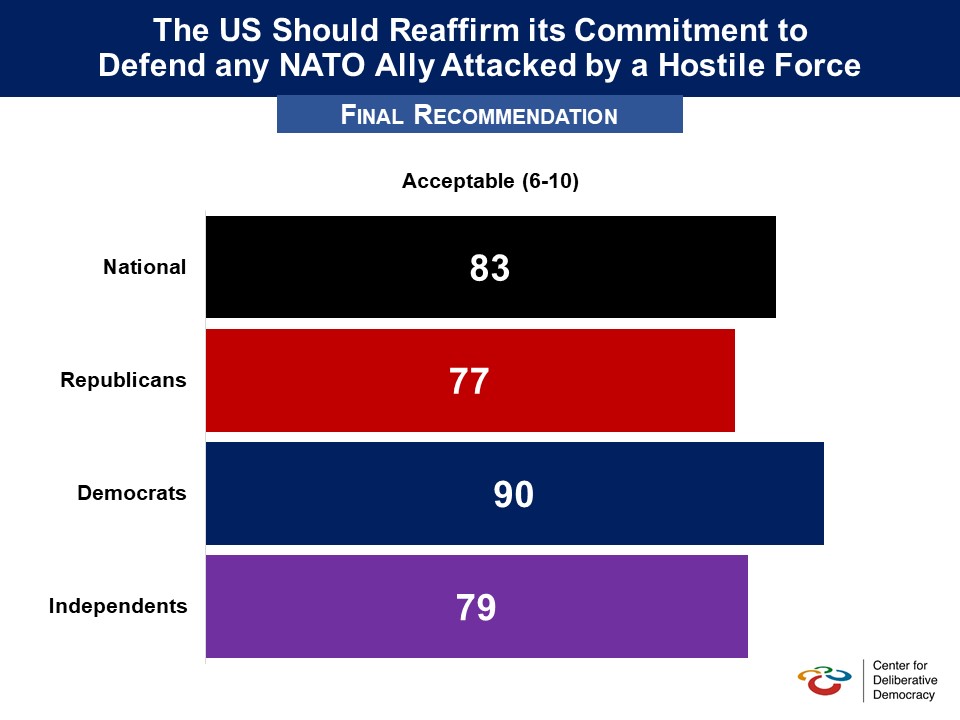 Pre-Deliberation Poll
Pre-Deliberation Poll


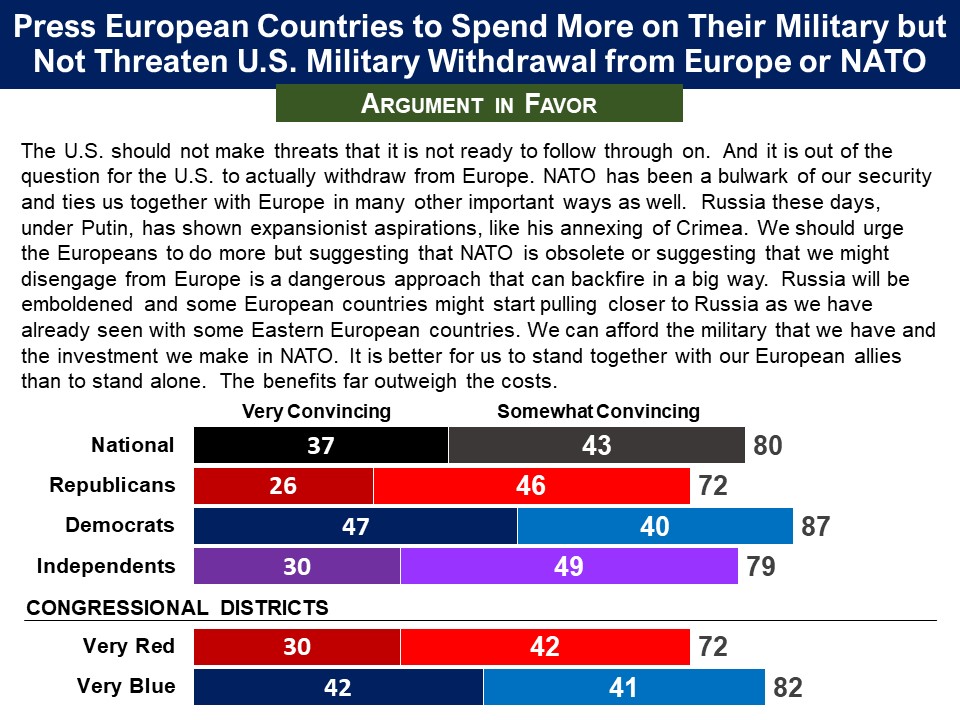 They were presented the third proposal and an argument in favor:
They were presented the third proposal and an argument in favor: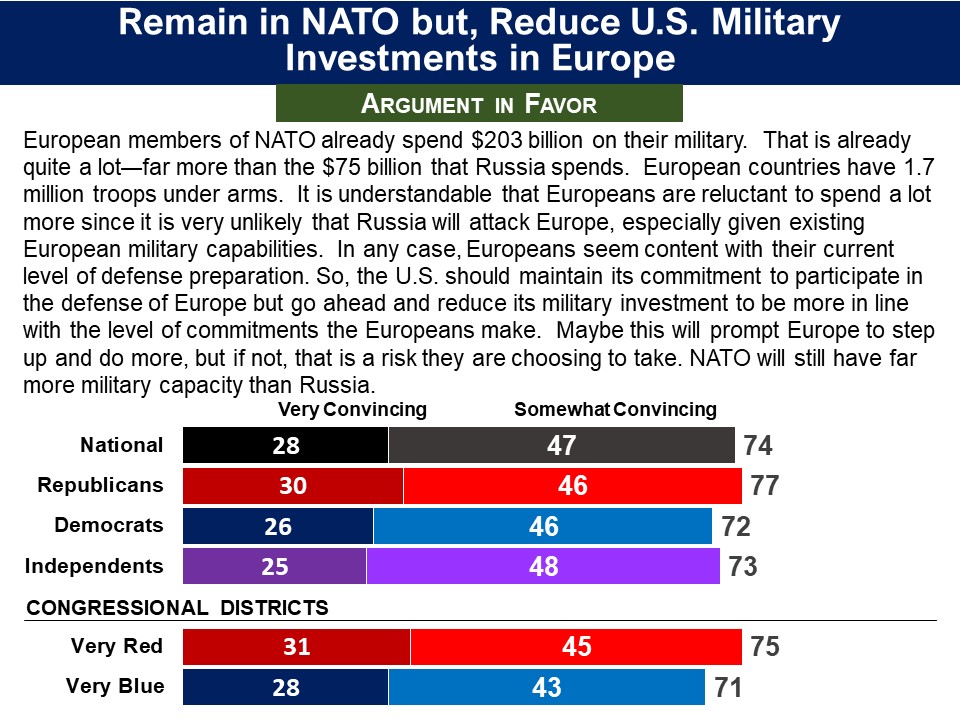 Asked for their final recommendation, the least attractive option was to threaten withdrawal from Europe and NATO, which was endorsed by just 12% overall—one in five Republicans and a miniscule 4% of Democrats. The clear favorite, endorsed by about half overall and by both parties, was the third option: remaining part of NATO but reducing US military spending in line with European defense spending. The option of pressing the Europeans but not threatening withdrawal was endorsed by 35% overall— Republicans 29%, Democrats 41%.
Asked for their final recommendation, the least attractive option was to threaten withdrawal from Europe and NATO, which was endorsed by just 12% overall—one in five Republicans and a miniscule 4% of Democrats. The clear favorite, endorsed by about half overall and by both parties, was the third option: remaining part of NATO but reducing US military spending in line with European defense spending. The option of pressing the Europeans but not threatening withdrawal was endorsed by 35% overall— Republicans 29%, Democrats 41%.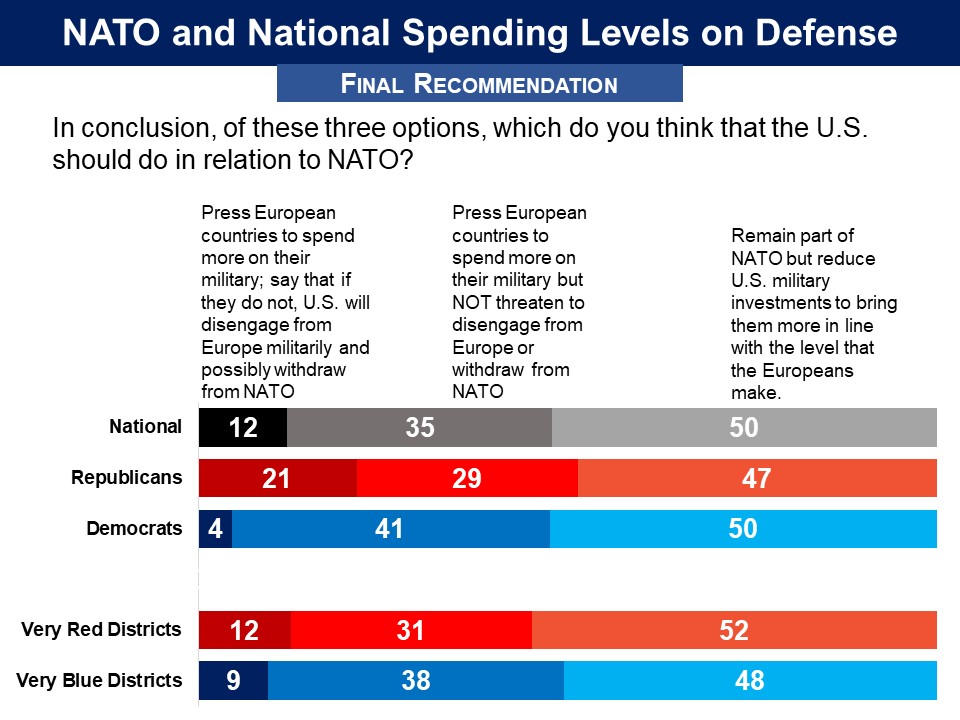 Related Standard Polls
Related Standard Polls












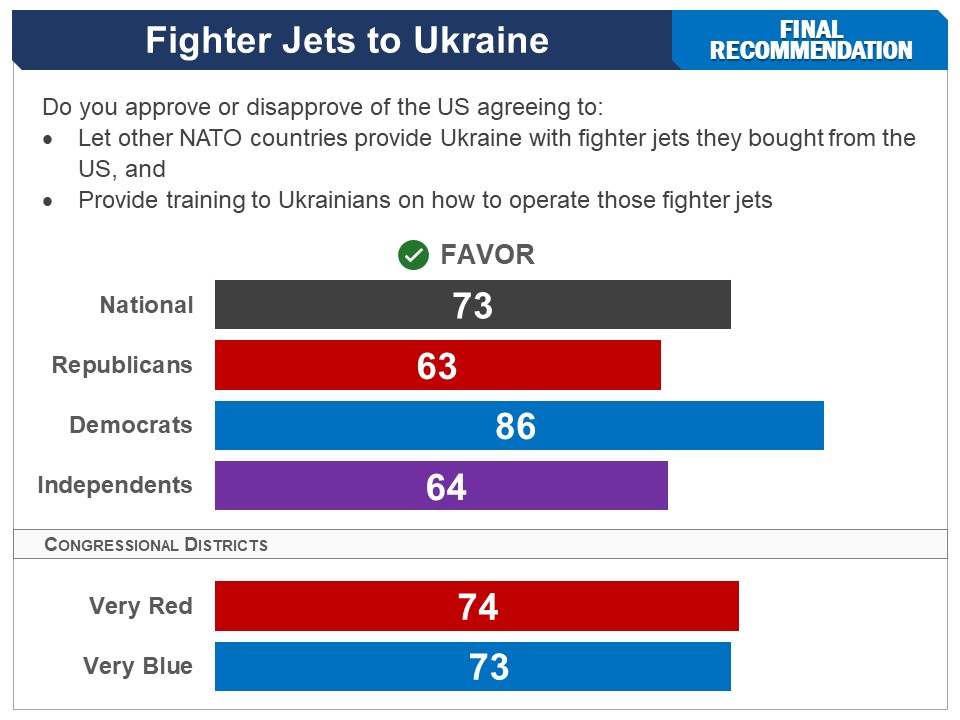

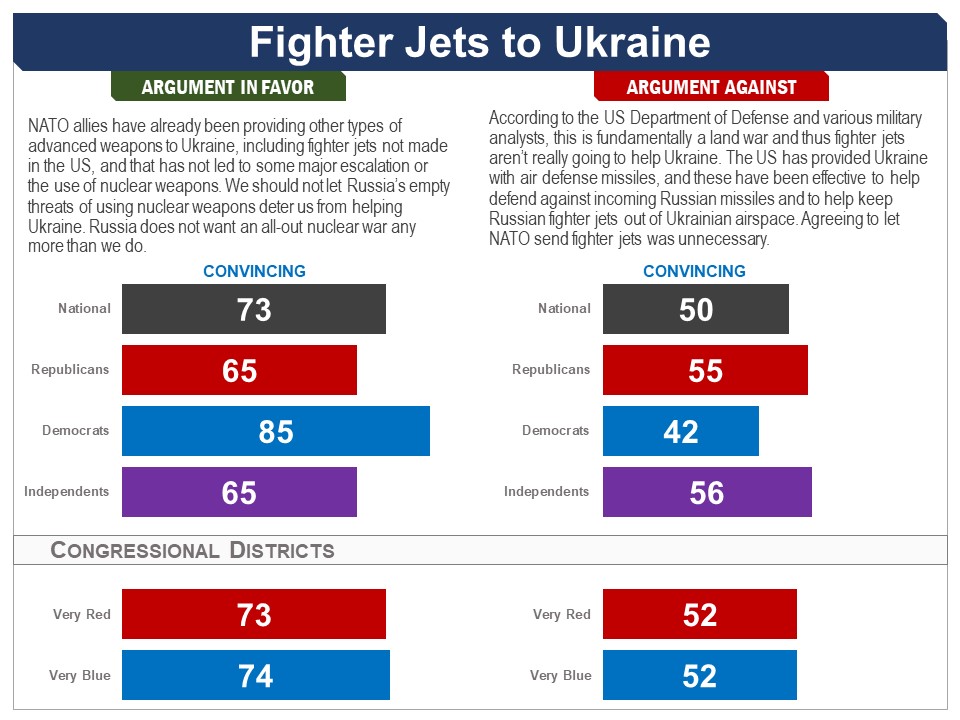
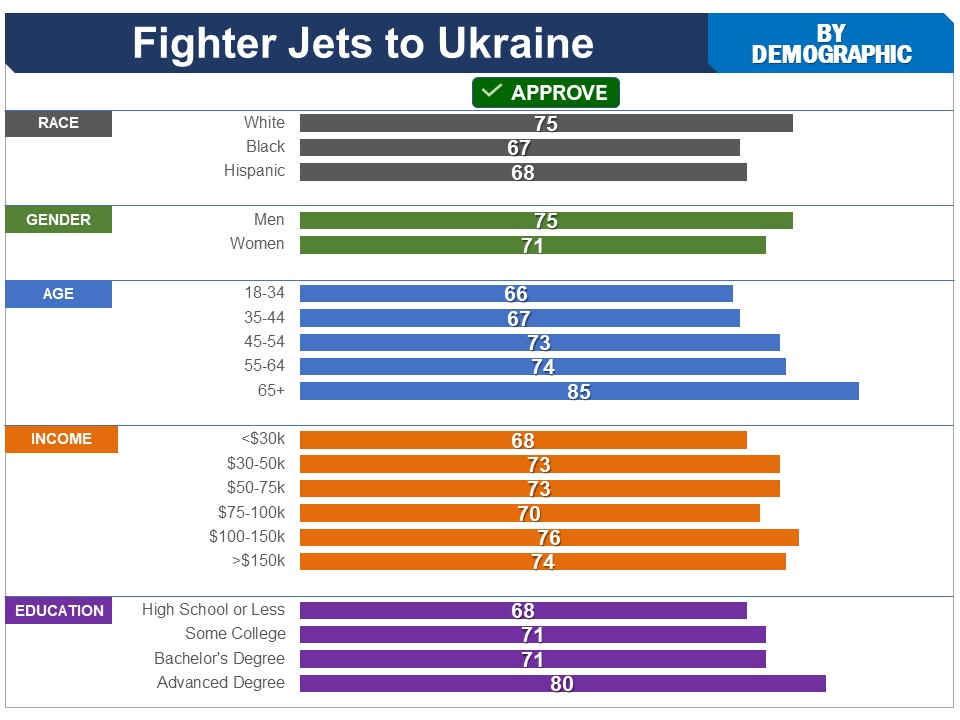


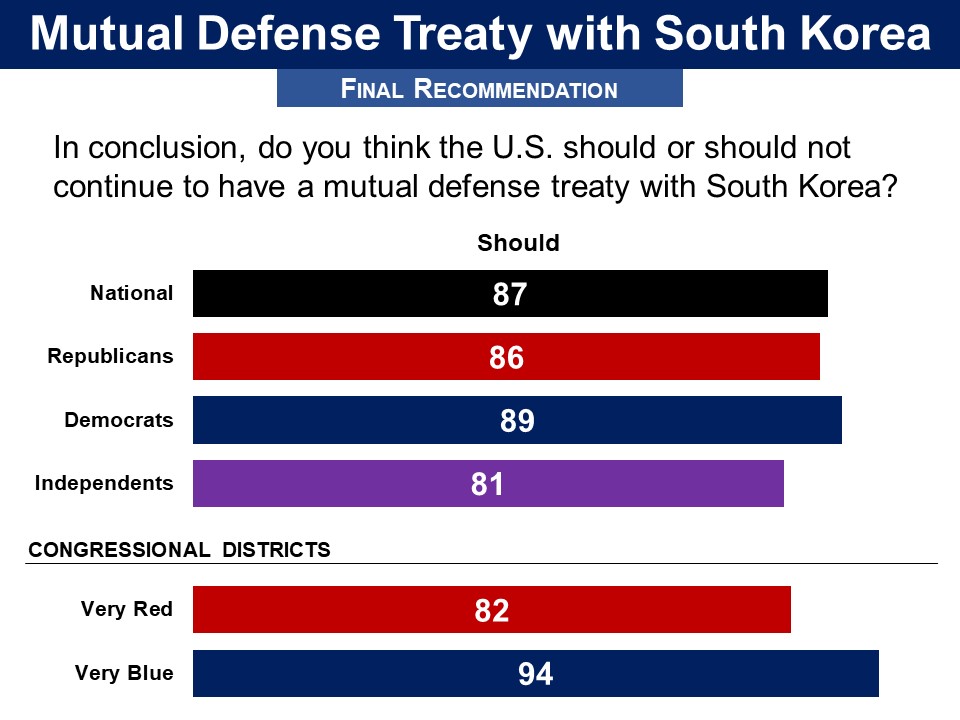
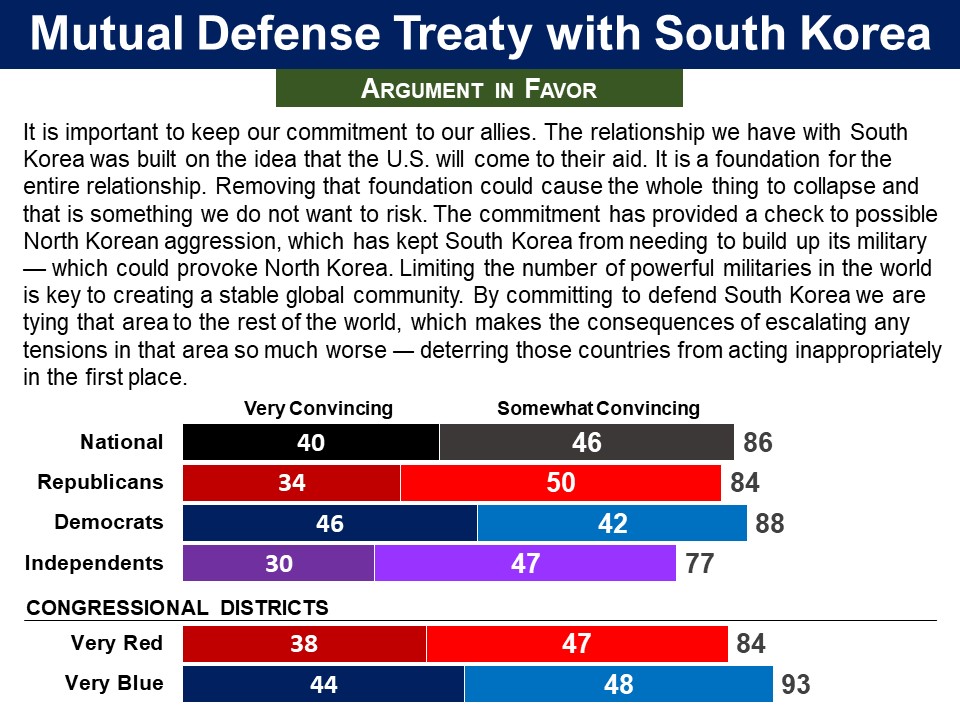
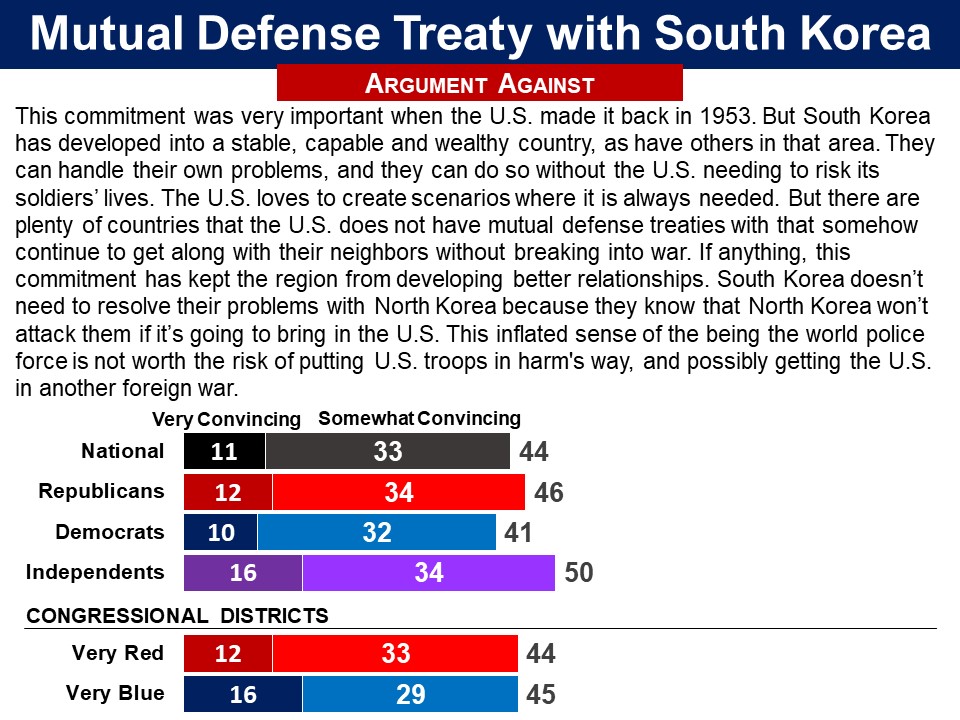
 Related Standard Polls
Related Standard Polls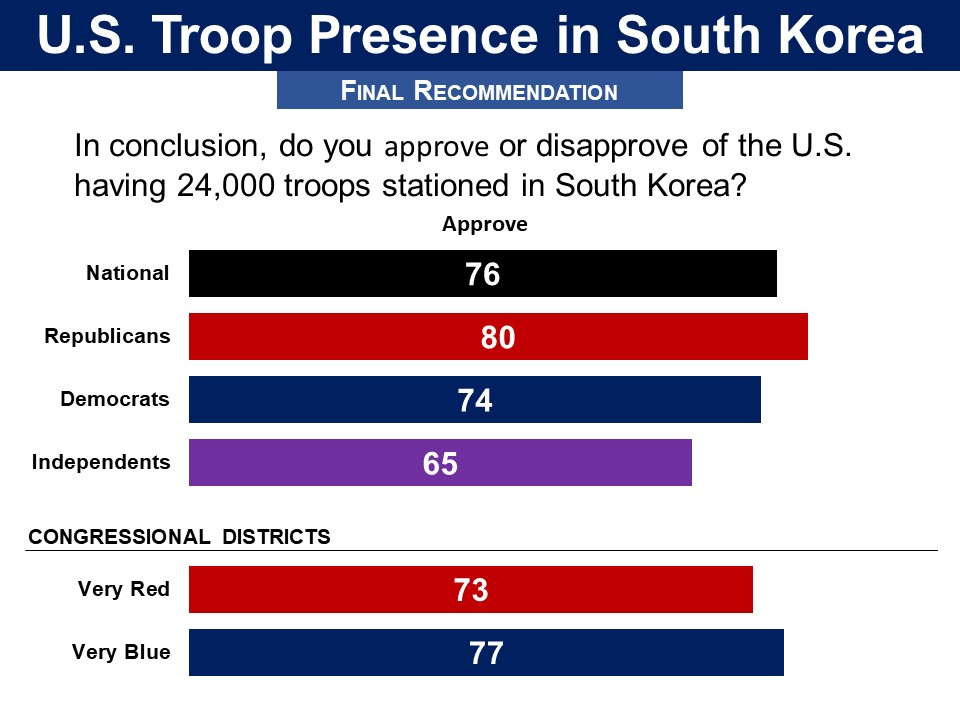
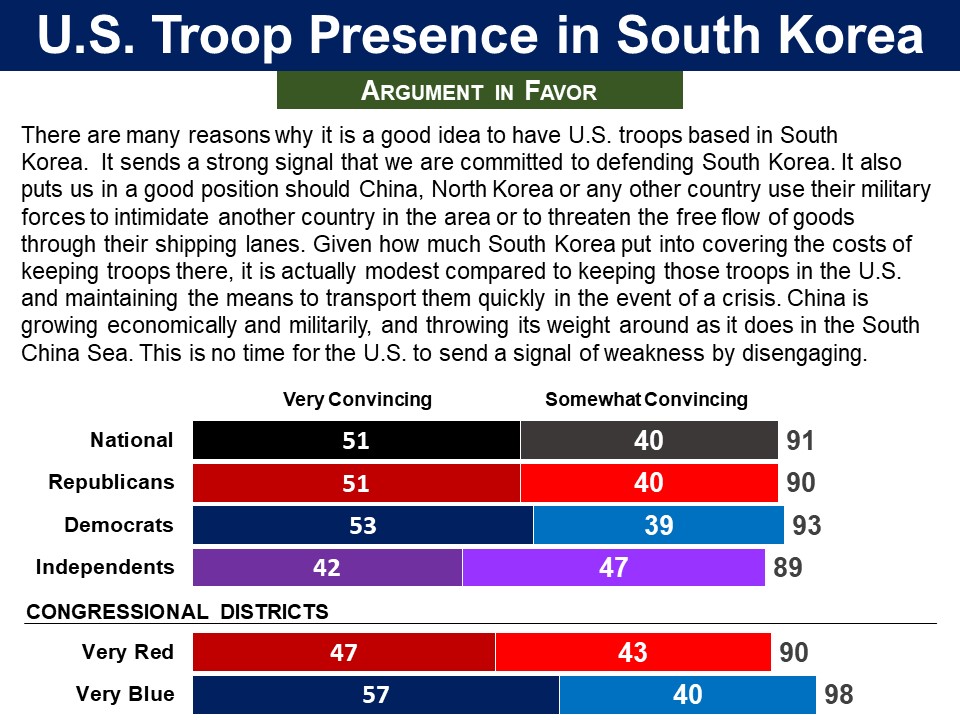
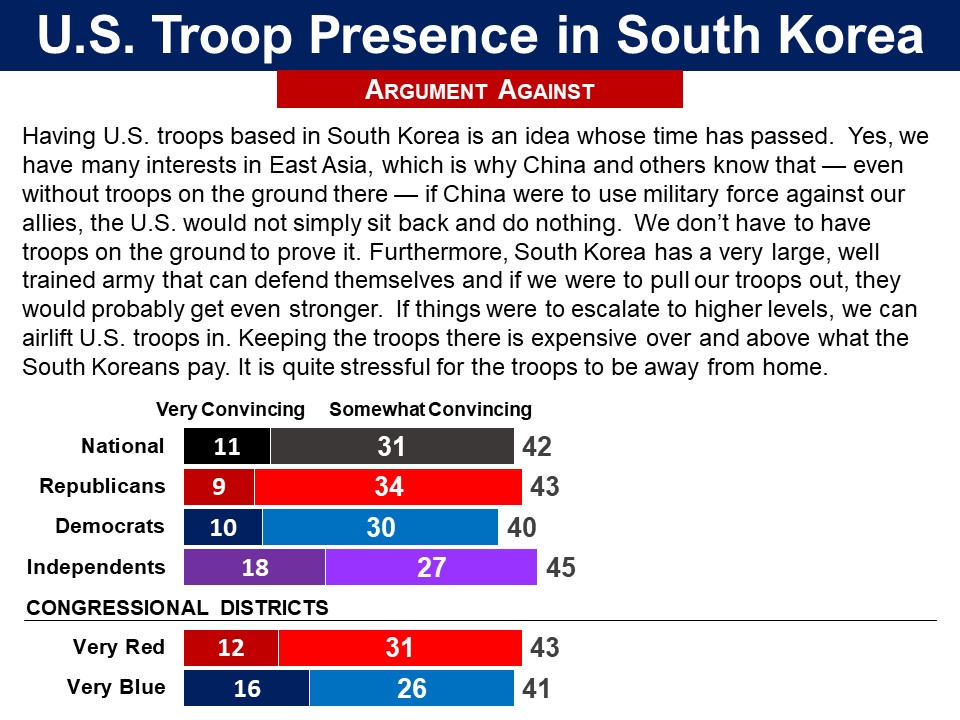
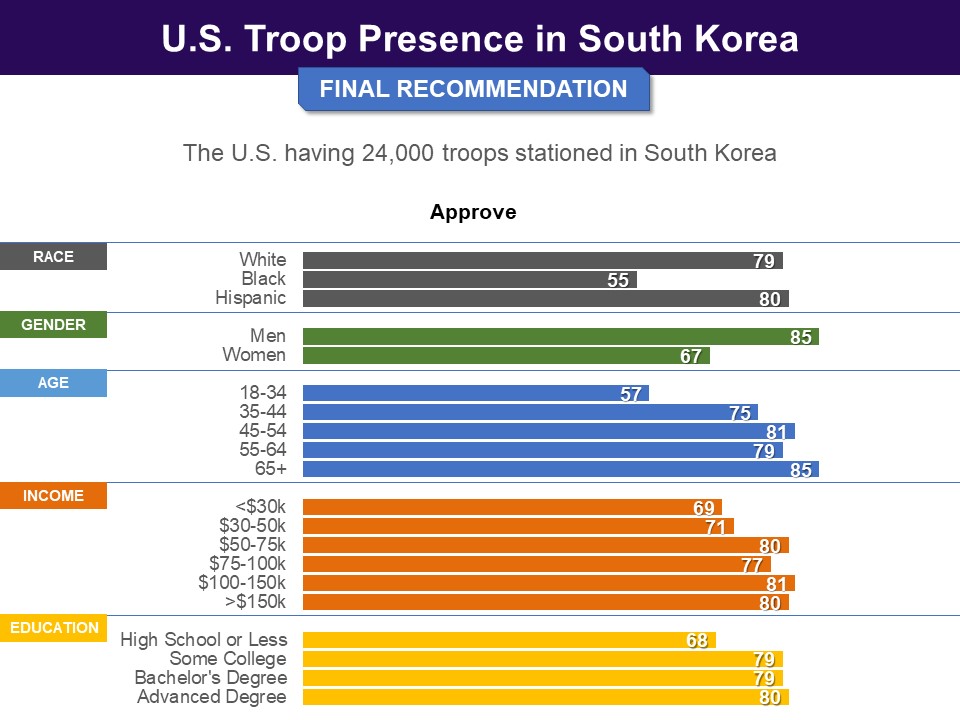 Related Standard Polls
Related Standard Polls
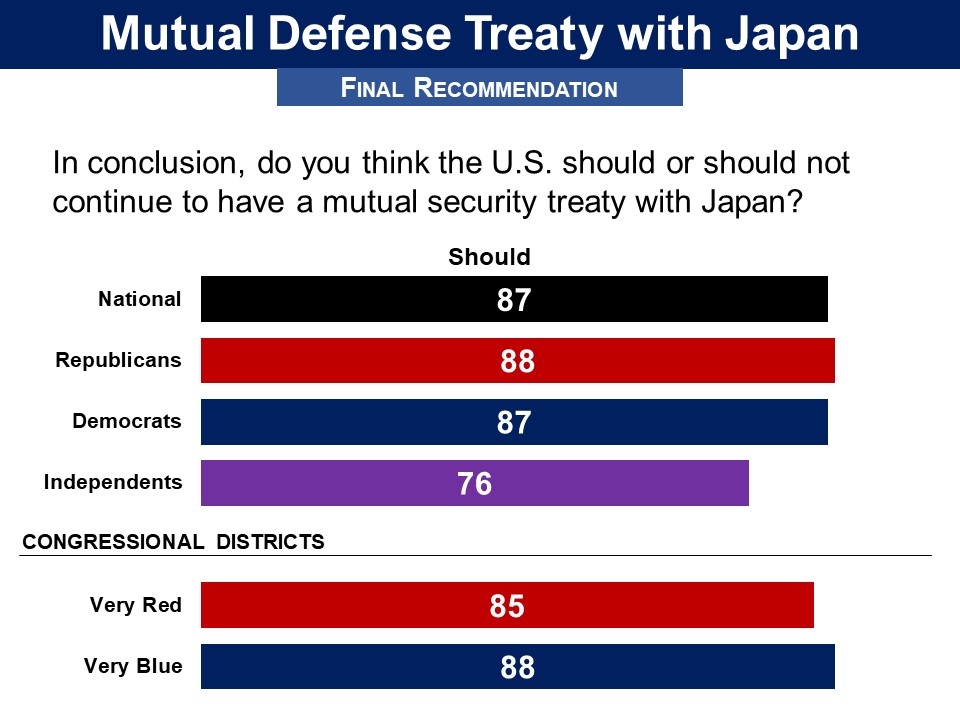
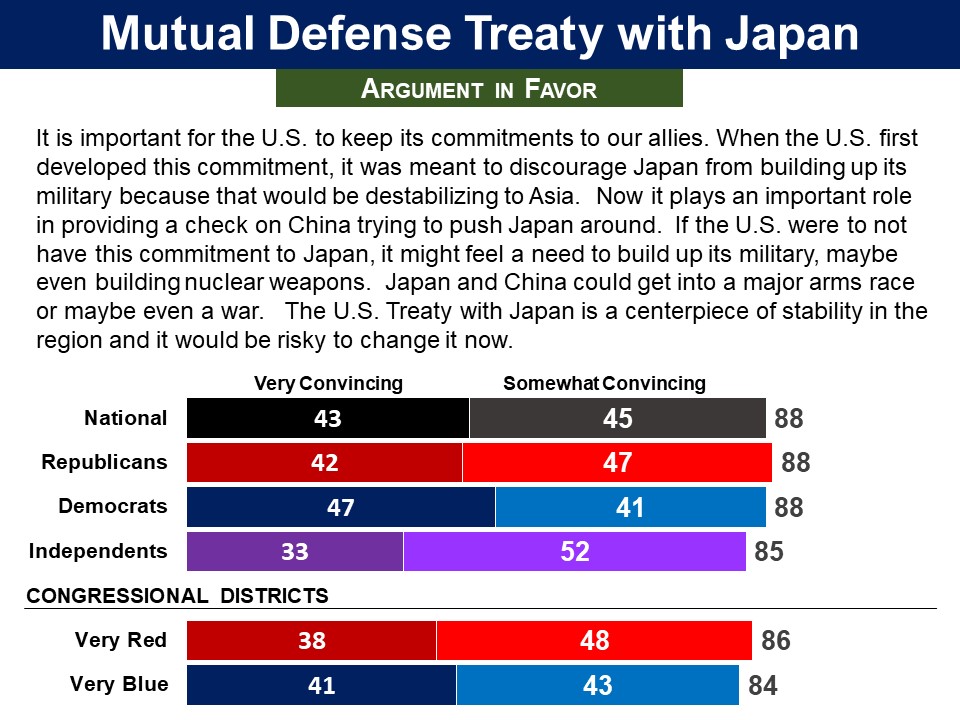
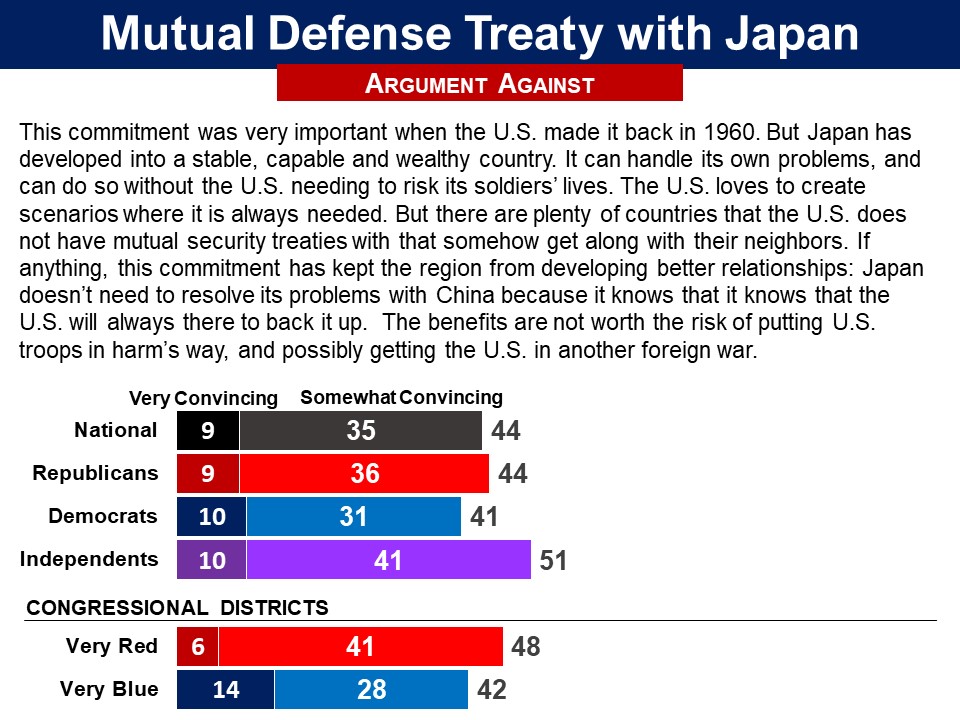
 Related Standard Polls
Related Standard Polls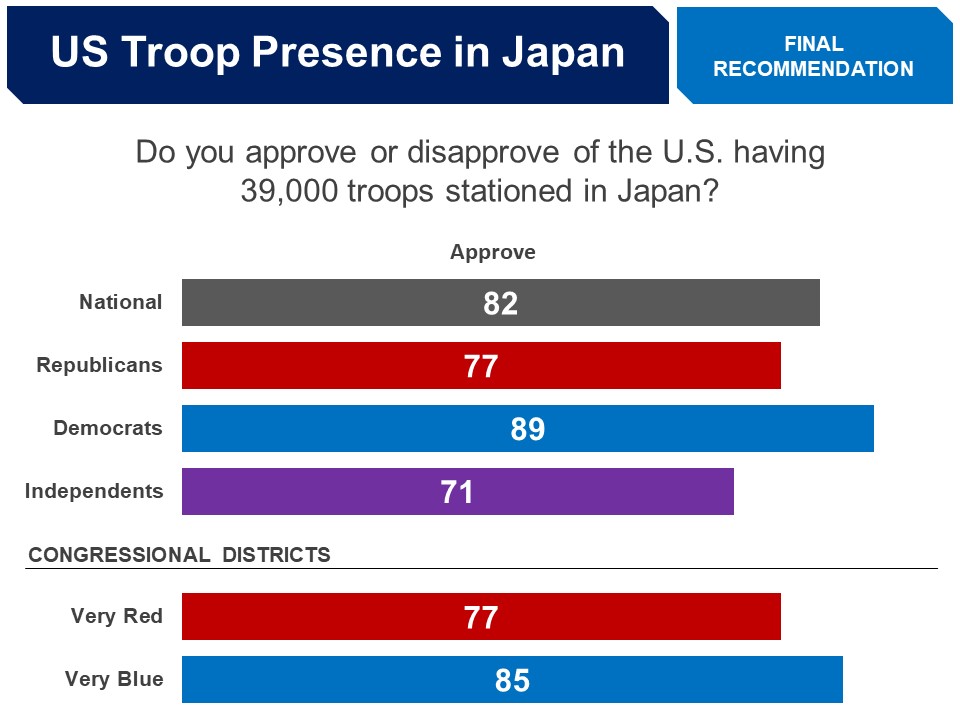
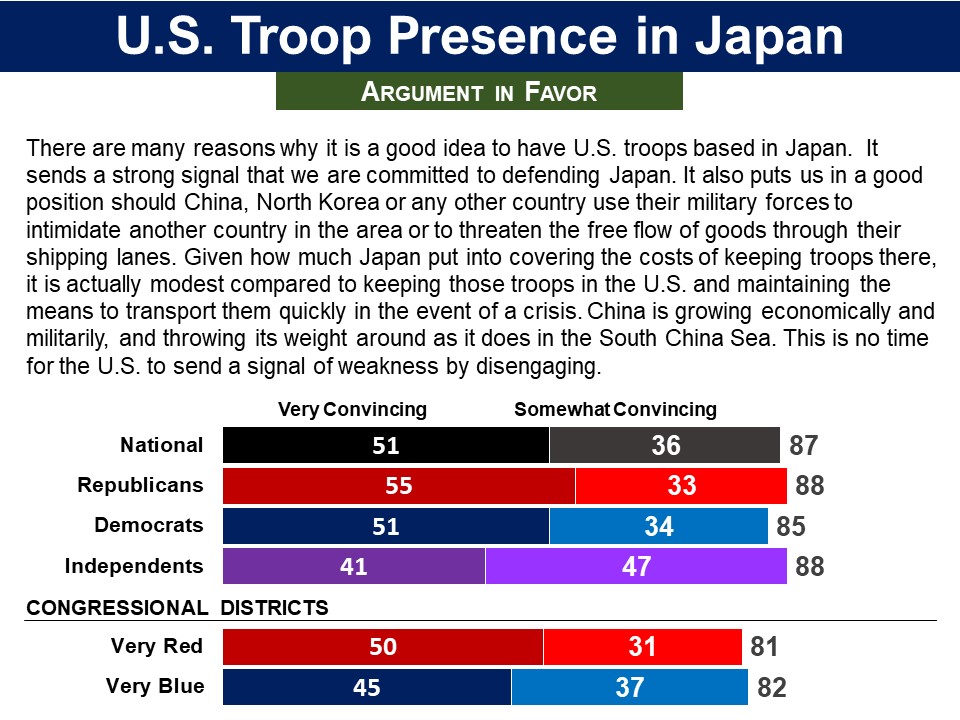

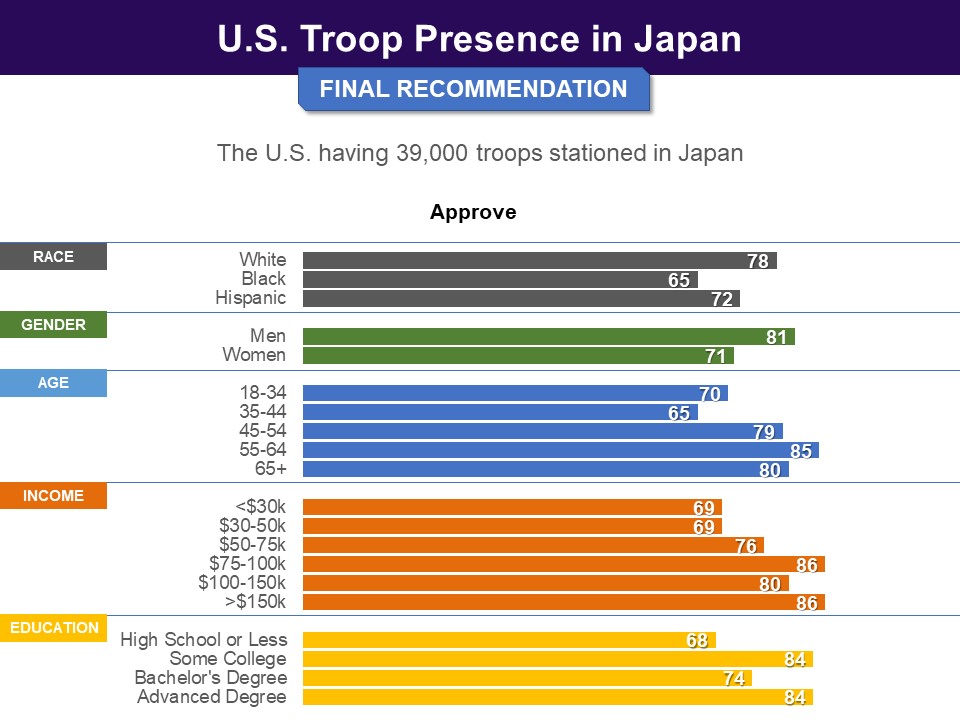 Related Standard Polls
Related Standard Polls


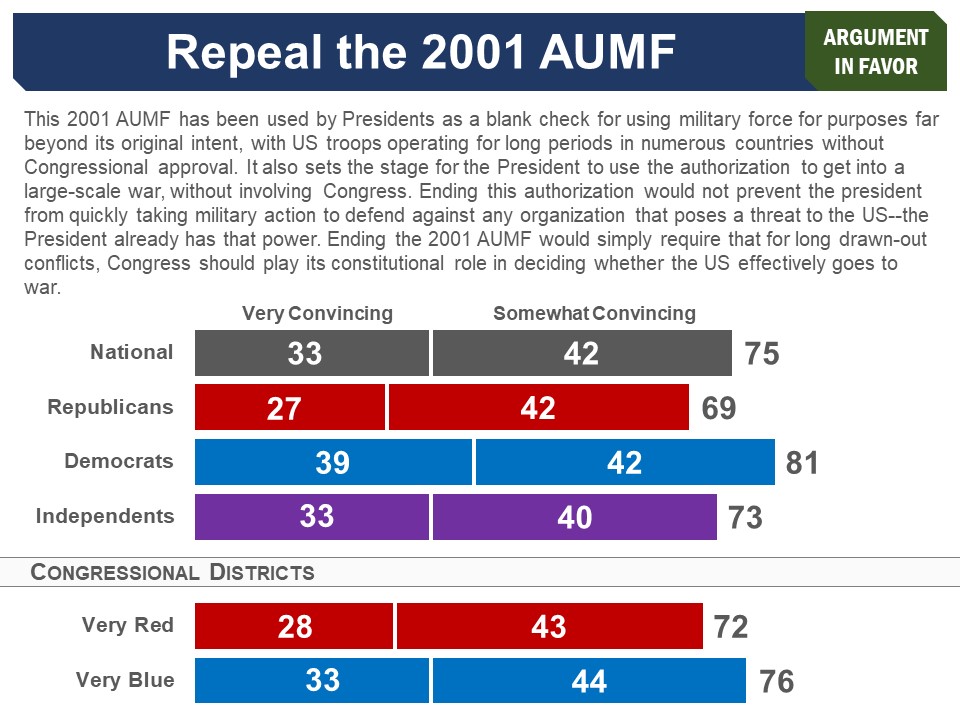
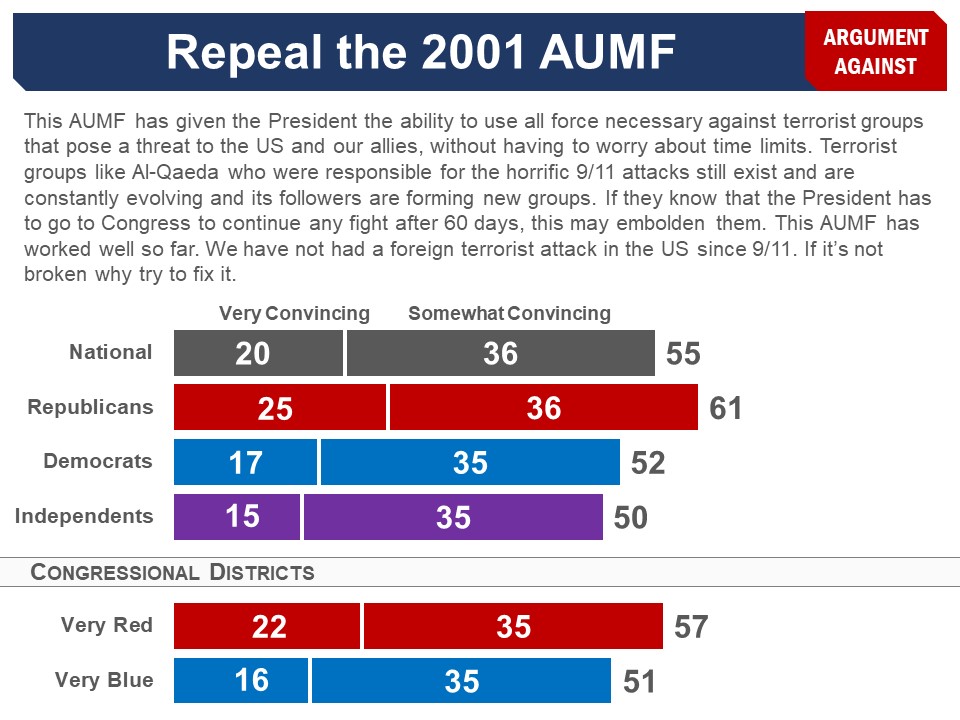






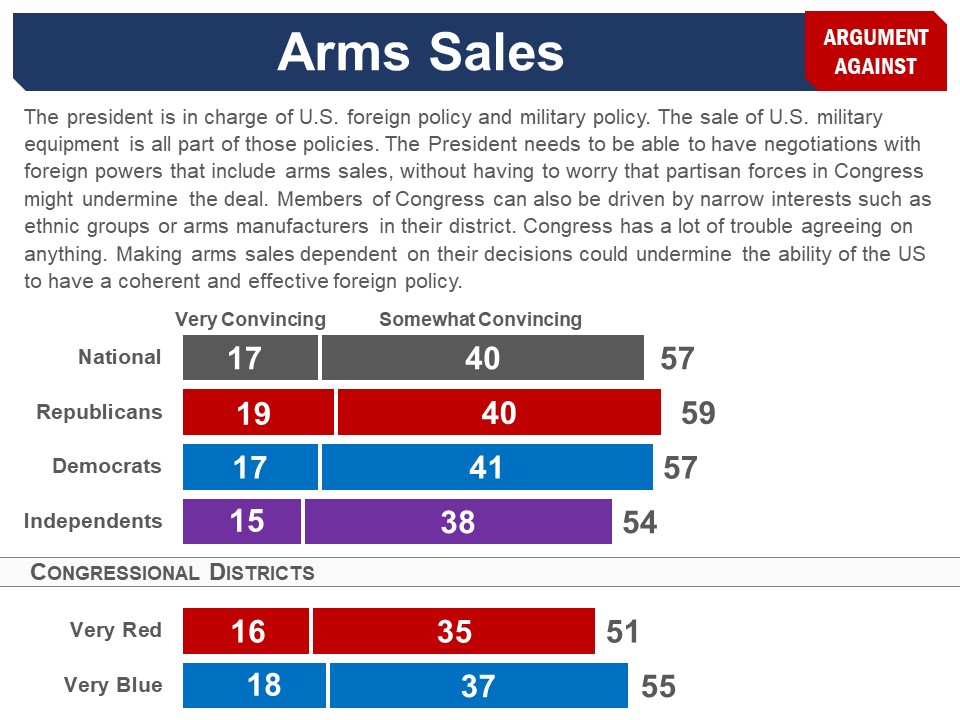
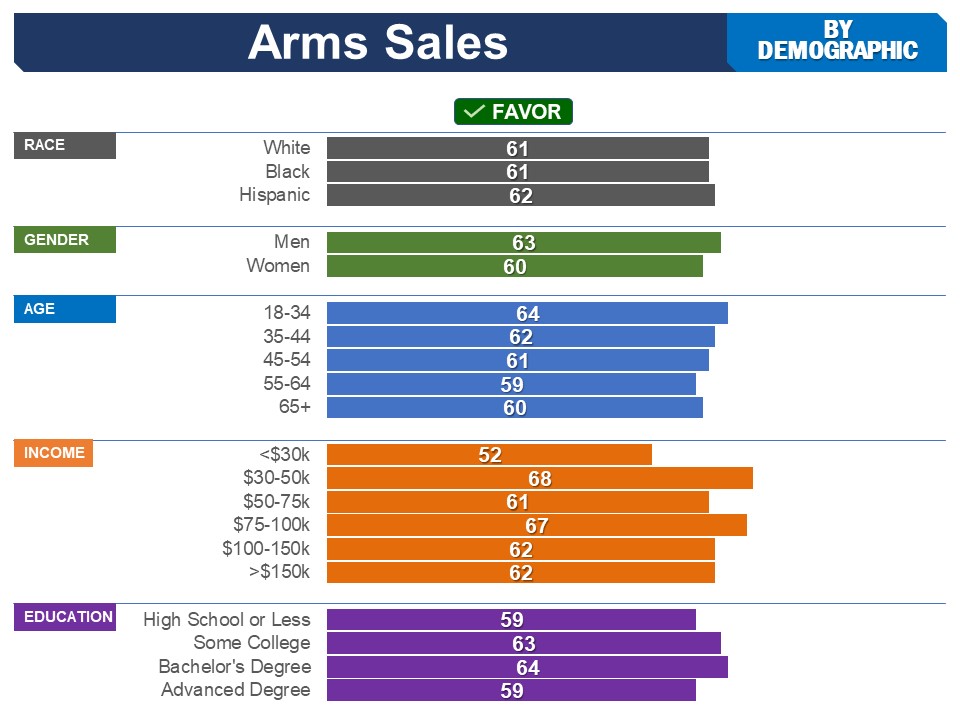




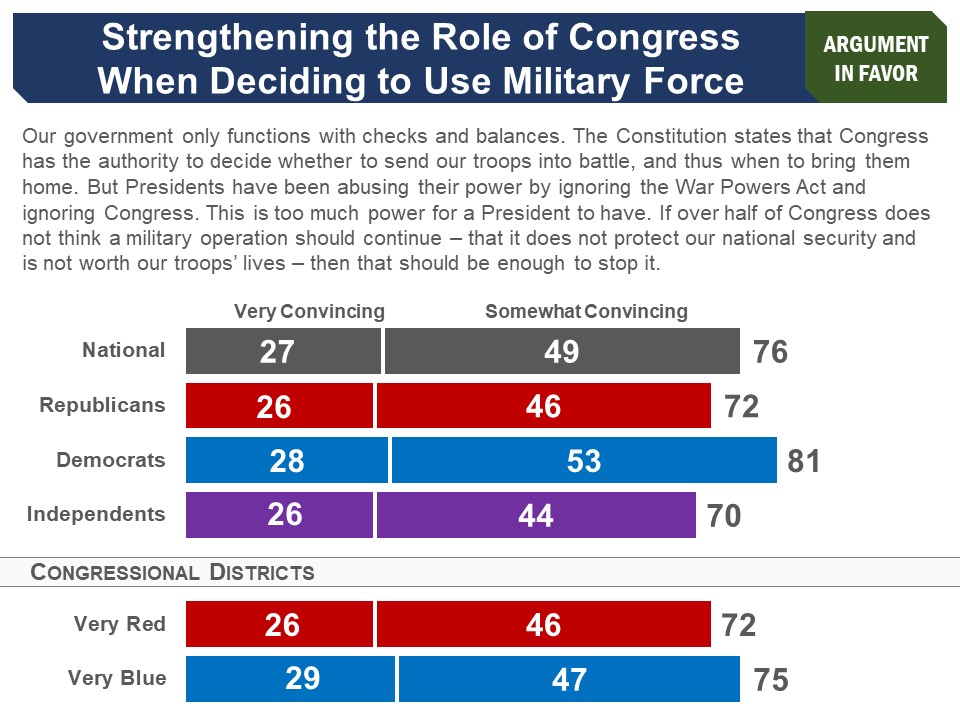
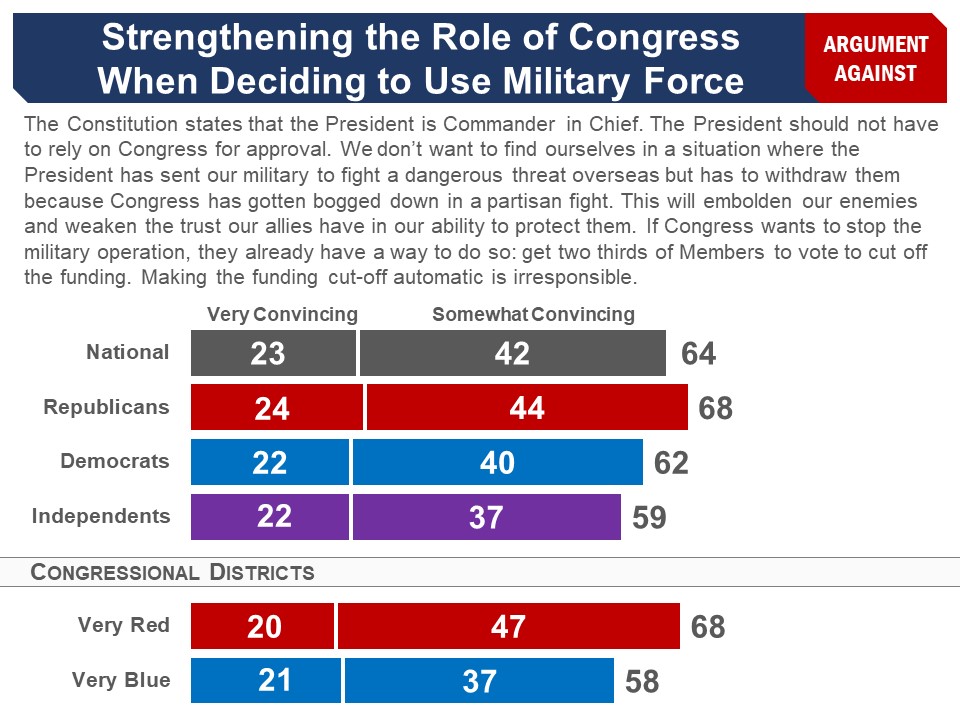
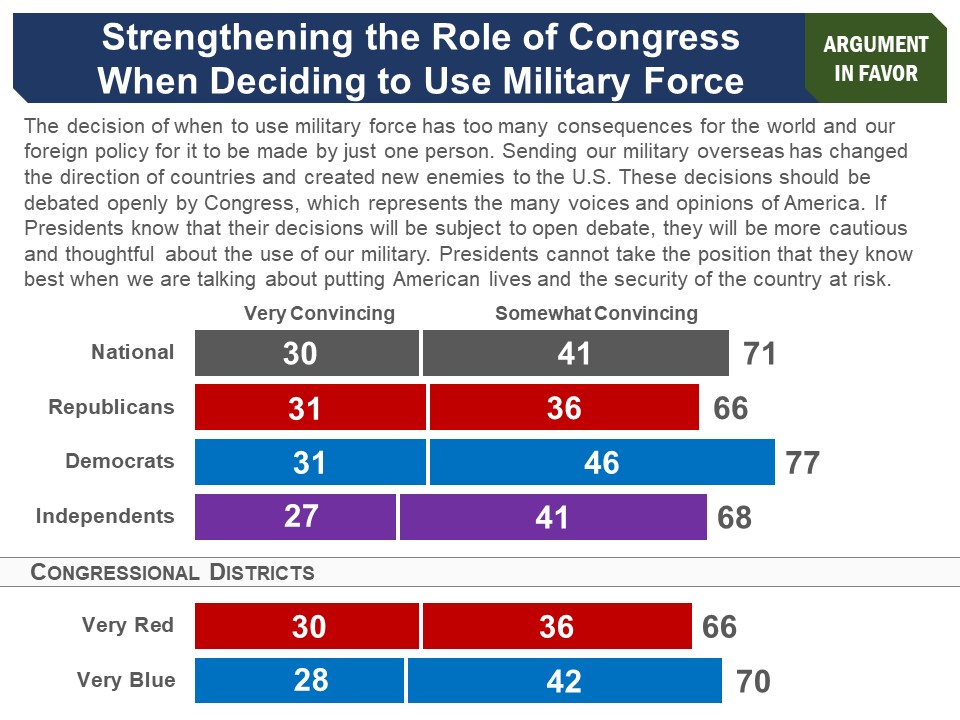
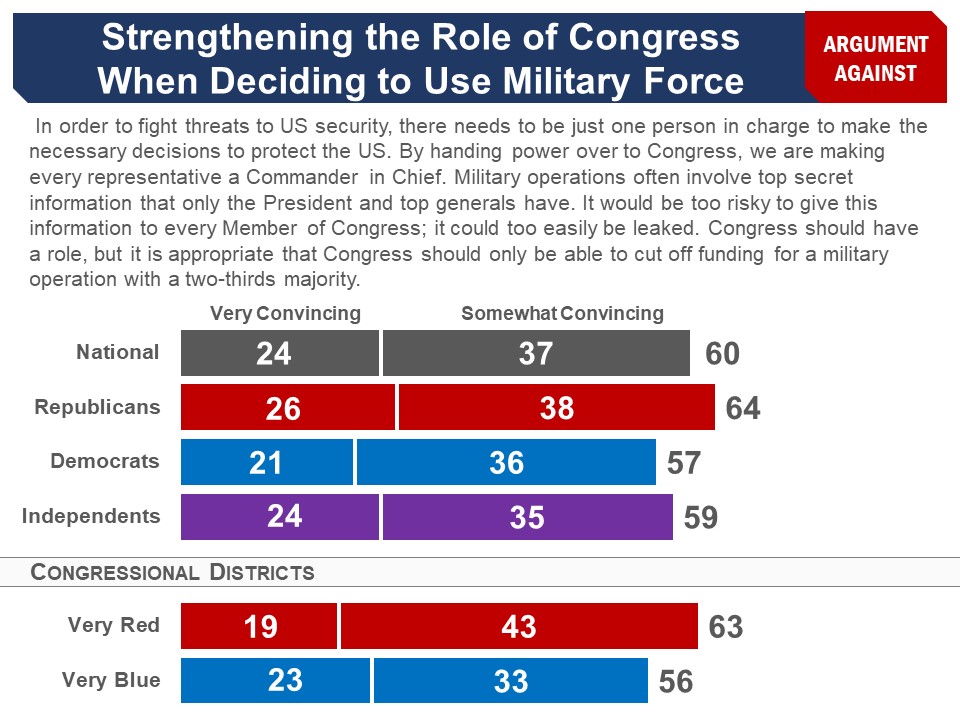






















 j
j




